I found a breakdown of the IMDb Top 250 movies by genre here (as of October 2008).
And it occured to me that you can see historical lists of IMDb's Top 250 films using the Internet Archive (also try this link). Back in 1996, IMDb users rated Star Wars as the number one film, and Trainspotting as number two...
Monday, February 09, 2009
Snapshot afterthoughts
Labels:
films,
IMDb,
Internet Archive,
movies,
snapshot,
Star Wars,
Top 250,
Trainspotting
Snapshot of IMDb's Top 250 films - Feb 2009
I don't know why I didn't think of this before, but wouldn't it be interesting to see how the Top 250 changes over time?
Below is a snapshot of how it looks today. Since I blogged about them:
7 films have gone up in the ranking (including The Prestige, which gained an impressive 104 places).
6 have stayed the same (including Little Miss Sunshine, dammit!).
And the rest have gone down - including five films that have disappeared from the Top 250 altogether (Walk the Line, Star Wars III, Pirates I, Hero and - I'm particularly disappointed about this one - Almost Famous).
My mission is about 14% complete...
IMDb Top 250 films as of 09 February 2009:
Below is a snapshot of how it looks today. Since I blogged about them:
7 films have gone up in the ranking (including The Prestige, which gained an impressive 104 places).
6 have stayed the same (including Little Miss Sunshine, dammit!).
And the rest have gone down - including five films that have disappeared from the Top 250 altogether (Walk the Line, Star Wars III, Pirates I, Hero and - I'm particularly disappointed about this one - Almost Famous).
My mission is about 14% complete...
IMDb Top 250 films as of 09 February 2009:
Sunday, February 08, 2009
Frost/Nixon
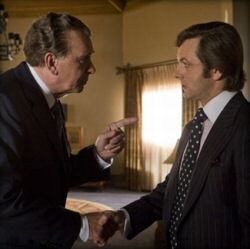 #243 at time of writing.
#243 at time of writing.Ron Howard's competent film adaptation of Peter Morgan's play dramatises the famous interviews between David Frost and recently-resigned Richard Nixon from 1977.
The story remains reasonably faithful to the facts; the occasional edit or flourish adds to the drama without undermining the truth (cf Pearl Harbour and the like). You might say the film captures what the collective consciousness remembers of the Frost/Nixon interviews, rather than exactly what happened.
Frank Langella plays Nixon brilliantly, as a fallen man desperate for an act of contrition but still in too deep with his old trickery and slick ways. The film leaves us feeling satisfied that America got its confession from the dastardly Nixon, but it also leaves us feeling sympathy for the man.
Fascinating, but not really a must-watch film. It'll be off the Top 250 in a week.
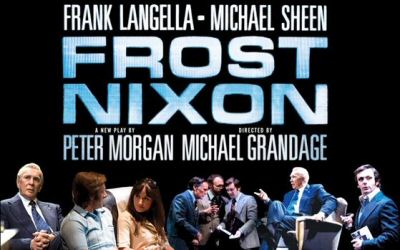
Labels:
1977,
biopic,
David Frost,
films,
Frank Langella,
Frost/Nixon,
movies,
Peter Morgan,
review,
Richard Nixon,
Ron Howard
Saturday, February 07, 2009
Memento
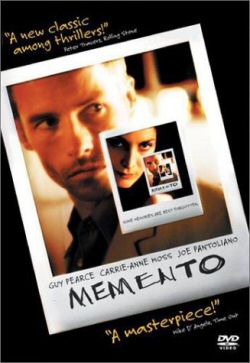 #27 at time of writing.
#27 at time of writing.After watching Memento at the cinema I left with my head spinning... I love films that do that. If you like twists, this is the twistiest.
Leonard (Guy Pearce) is determined to find his wife’s killer. However, the attack left him suffering from a type of amnesia whereby he can no longer store new memories. He can remember events before the attack, but not what happened fifteen minutes ago. Therefore, he relies on a system of notes, photos and tattoos on his body to record information about himself and others. This unique thriller unfolds in two separate narratives, one in chronological order and one in reverse, so the audience experiences the same disorientation as Leonard.
I have heard it argued that this backwards storytelling is a gimmick that could have been applied to any film (and indeed there are other films that use reverse chronology - see Betrayal and Irréversible). Certainly, this kind of storytelling could come easily to a director who is used to filming things out of sequence. Perhaps that's true, but Memento transcends gimmickry. The story could not have been told better any other way.
With this and the Batman films under his belt, director Chris Nolan is shaping up to be an all-time great, even if he does look uncannily like Harry Enfield.
Labels:
Batman,
Betrayal,
Christopher Nolan,
films,
Guy Pearce,
Harry Enfield,
Irreversible,
Memento,
movies,
review
Friday, February 06, 2009
London’s most famous tube station
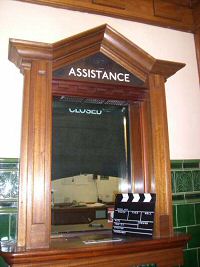 Aldwych tube station, formerly known as Strand, was built in 1907 as an offshoot of the Piccadilly Line. Because the branch is entirely self-contained, and was always closed at weekends, it has long been a popular location for film and television companies wanting to film on the Underground.
Aldwych tube station, formerly known as Strand, was built in 1907 as an offshoot of the Piccadilly Line. Because the branch is entirely self-contained, and was always closed at weekends, it has long been a popular location for film and television companies wanting to film on the Underground.The station closed to the public in 1994, but it has been reasonably well-preserved, and for £1000 an hour (not including the use of a train) you can bring in your own film crew.
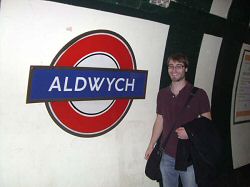 Thanks to Transport for London’s Film Office, I recently had a look around. We were shown the defunct lift shafts that spelled the station’s doom when their repair bill was deemed uneconomical, and then we descended the winding spiral staircase.
Thanks to Transport for London’s Film Office, I recently had a look around. We were shown the defunct lift shafts that spelled the station’s doom when their repair bill was deemed uneconomical, and then we descended the winding spiral staircase.Aldwych’s remaining platform is used to test mock-up designs for new signage, tilework and advertising systems. The walls feature replicas of posters from decades gone by. The trackwork and infrastructure remains in good condition, and a train of ex-Northern Line 1972 tube stock is permanently stabled on the branch, which can be driven up and down the branch for filming and to keep the trackwork in good repair.
We walked through the train used in V for Vendetta; we peered into the tunnel used for The Prodigy’s Firestarter music video; and we imagined the wave of water through the corridor as depicted in Atonement (where Aldwych stood in for Balham station). That water, we were told, was CGI; film crews are expected to leave the station as they found it. Which isn’t always easy – goodness knows how the film crew for Creep cleared up after releasing hundreds of real rats into the empty lift shafts!
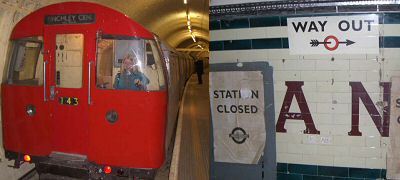
Labels:
Aldwych,
Atonement,
Creep,
films,
Firestarter,
London Underground,
movies,
TfL,
The Prodigy,
Transport for London,
V for Vendetta
Thursday, February 05, 2009
The Dark Knight
#5 at time of writing.
I've seen The Dark Knight twice - once at the UK premiere, and once at the excellent Roxy Bar and Screen on Borough High Street. Both times, I was on the edge of my seat with anxiety for the full two and a half hours. This is no mere superhero movie – it is an epic crime drama of remarkable complexity and substance, tackling sweeping themes of retribution and sacrifice.
Whether this film deserves to be scored as the fifth best film of all time - or even the #1 film as it was for a few weeks on IMDb - is moot, but it's hard to deny that it is an incredibly powerful cinematic experience. (It came out the same week as Wall·E - what a week that was for the silver screen!)
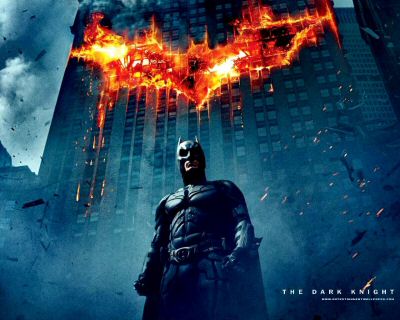
Heath Ledger’s untimely death in January 2008 ensured that the Hollywood hype machine would be in overdrive, but incredibly his performance - and the whole film - lives up to even the most excessive expectations.
Heath Ledger's apocalyptic performance is certainly Oscar-worthy. Compare the Joker to Ennis Del Mar from Brokeback Mountain and it's very hard to believe that they are the same person.
It’s not flawless. It's long, Bale’s Batman voice is sometimes over-the-top, and, well, it’s not Batman Begins. But the scale, tension and sheer dark depths of the characters will leave you in awe.
(A far cry from my opinion of Batman & Robin...)
I've seen The Dark Knight twice - once at the UK premiere, and once at the excellent Roxy Bar and Screen on Borough High Street. Both times, I was on the edge of my seat with anxiety for the full two and a half hours. This is no mere superhero movie – it is an epic crime drama of remarkable complexity and substance, tackling sweeping themes of retribution and sacrifice.
Whether this film deserves to be scored as the fifth best film of all time - or even the #1 film as it was for a few weeks on IMDb - is moot, but it's hard to deny that it is an incredibly powerful cinematic experience. (It came out the same week as Wall·E - what a week that was for the silver screen!)

Heath Ledger’s untimely death in January 2008 ensured that the Hollywood hype machine would be in overdrive, but incredibly his performance - and the whole film - lives up to even the most excessive expectations.
Heath Ledger's apocalyptic performance is certainly Oscar-worthy. Compare the Joker to Ennis Del Mar from Brokeback Mountain and it's very hard to believe that they are the same person.
It’s not flawless. It's long, Bale’s Batman voice is sometimes over-the-top, and, well, it’s not Batman Begins. But the scale, tension and sheer dark depths of the characters will leave you in awe.
(A far cry from my opinion of Batman & Robin...)
Wednesday, February 04, 2009
Wall·E
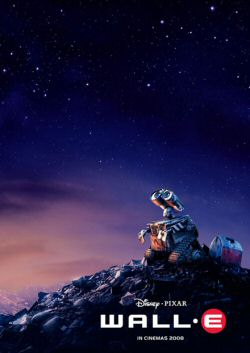 #39 at time of writing.
#39 at time of writing.The teasers for Wall·E had me salivating for more since Ratatouille graced our screens. With that much anticipation, it’s almost impossible not to be let down. But the truth is even more unlikely: My colossal expectations were not only met, but exceeded – with room to spare.
This fairytale of a robot who falls in love boasts a host of superlatives. It's the highest rated animated feature on IMDb. It's the most expensive animation ever made (it cost more than Waterworld). And it's the probably the movie with the least dialogue to ever be nominated for an Oscar for best original screenplay.
Director Andrew Stanton and the Pixar team watched one Charlie Chaplin and one Buster Keaton film every day for almost a year, to give them confidence in how a full range of emotions could be portrayed silently.
All that research paid off in spades. Sumptuous animation, endearing characters, the most romantic robots you've ever seen - this tongue-in-cheek cautionary tale is an instant classic.
Surely it can’t be THAT wonderful, I hear you say. Well, it's a bit preachy, linear, and has a couple of cheesy lines. But everyone knows there are only two kinds of Pixar films: great ones and perfect ones – and Wall·E is Pixar on top form.
Labels:
Andrew Stanton,
Buster Keaton,
Charlie Chaplin,
films,
movies,
Oscar,
Pixar,
Ratatouille,
review,
Wall-E,
Waterworld
Tuesday, February 03, 2009
Films for Free at a Monitor Near You
 There are 1000 megabytes in a gigabyte. There are 1000 gigabytes in a terabyte. And there are 1000 terabytes in a petabyte. The Internet Archive has been archiving the entire Internet since 1996, and now contains nearly two petabytes of information – more than even the world’s largest library.
There are 1000 megabytes in a gigabyte. There are 1000 gigabytes in a terabyte. And there are 1000 terabytes in a petabyte. The Internet Archive has been archiving the entire Internet since 1996, and now contains nearly two petabytes of information – more than even the world’s largest library.Among that ocean of information is a huge archive of copyright-free and copyright-expired movies. Last week, I browsed the Moving Image Archive and treated myself to a string of films from the dawn of cinema.
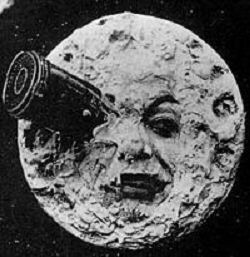 I started with Le voyage dans la lune, a short film created in 1902 by Georges Méliès. Méliès created a number of special effects that are still used today, and is credited as the first person to use celluloid to tell self-contained stories.
I started with Le voyage dans la lune, a short film created in 1902 by Georges Méliès. Méliès created a number of special effects that are still used today, and is credited as the first person to use celluloid to tell self-contained stories.With my appetite whetted, I spent the next few hours downloading and absorbing Buster Keaton, Charlie Chaplin, Fritz Lang, The Man With a Movie Camera, Battleship Potemkin, Nosferatu – and a few Merrie Melodies along the way.
These golden oldies are a pleasure to experience on two levels. First, because they are oddly familiar. The styles and stories, the idioms and issues that characterize the range of cinematic possibility as we perceive it today, were nearly all present from the very beginning. And secondly, never mind the historical interest, they are just wonderful films on their own terms – a great joy to watch.
Monday, February 02, 2009
The Thing
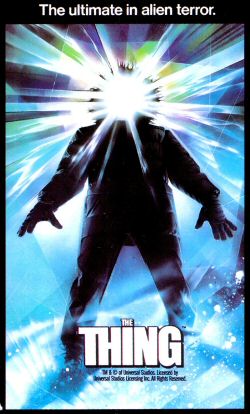 #174 at time of writing.
#174 at time of writing.John Carpenter’s sci-fi horror movie about a shape-shifting alien is as chilling now as it was when I first saw it almost a decade ago, inducing an unshakeable sense of paranoia.
This remake of 1951 film The Thing from Another World somehow manages to make the lonely ice sheets of the Antarctic feel breathtakingly claustrophobic. Much of it was filmed high in the mountains near Stewart in British Columbia.
In August 2003 a couple of hard-core fans, Todd Cameron and Steve Crawford, ventured to the remote filming location and, after 21 years, found remains of the Outpost #31 set and the Norwegian helicopter. The rotor blade from the chopper now belongs to Todd and rests in his collection of memorabilia from the film.
The special effects - which have dated somewhat, but are still unsettlingly creepy - were considered a new high-water mark at the time this film was released, all the more impressive when you discover that effects designer Rob Bottin was only 22 when he started the project.
Comically, There is a character name "Mac" and another named "Windows"; since the film was made in 1982, this is purely coincidental.
Labels:
British Columbia,
films,
John Carpenter,
movies,
review,
Rob Bottin,
Steve Crawford,
The Thing,
Todd Cameron
Sunday, February 01, 2009
Letters from Iwo Jima
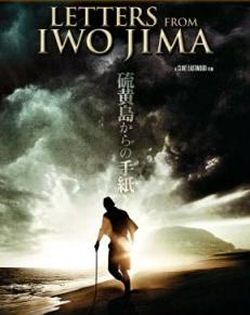 #187 at time of writing.
#187 at time of writing.It could have been seen as a gimmick when Clint Eastwood decided to film the story of the Battle of Iwo Jima from both the American perspective (Flags of Our Fathers) and the Japanese perspective (Letters from Iwo Jima). But it is not a gimmick.
This film is remarkably brave, honest and non-Hollywood. It portrays the Japanese soldiers as ordinary people forced by circumstance to battle for a lost cause, abandoned by the mainland and doomed by an insane cultural fear of losing face. It's visceral in scope and personal in tone, and there's always an assured hand in dealing with the performances and characters.
There are some desperately moving scenes as the soldiers and General Kuribayashi gradually realise the hopelessness of their situation. One of the most affecting aspects of the film is the tension between those soldiers that think it treasonous not to commit suicide in the face of failure, and those soldiers - the General included - who doubt the wisdom of such sacrifice.
As you watch the events unfold, you feel fear, loss, anger, and a mixture of sadness and admiration for the courage and persistent humanity of these ill-fated people.
This film is a significant, fascinating achievement.
Subscribe to:
Comments (Atom)



